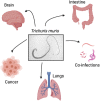Trichuris muris and comorbidities - within a mouse model context
- PMID: 34078488
- PMCID: PMC8660644
- DOI: 10.1017/S0031182021000883
Trichuris muris and comorbidities - within a mouse model context
Abstract
Trichuris muris is a mouse intestinal parasitic nematode that inhabits the large intestine of its host and induces a strong immune response. The effects of this strong anti-parasite response can be found locally within the intestinal niche and also systemically, having effects on multiple organs. Additionally, the anti-parasite response can have multiple effects on infectious organisms and on microbiota that the host is harbouring. It has been shown that Th1 responses induced by T. muris can affect progression of bowel inflammation, cause colitic-like intestinal inflammation, reduce barrier function and intestinal mucosal responses. In the brain, T. muris can exacerbate stroke outcome and other neurological conditions. In the lung, T. muris can suppress airway inflammation and alter immune responses to other parasites. Additionally, T. muris induced responses can inhibit anti-tumour immunity. Although this parasite maintains a localized niche in the large intestine, its effects can be far-reaching and substantially impact other infections through modulation of bystander immune responses.
Keywords: Trichuris muris; cancer; co-infections; comorbidity.
Conflict of interest statement
The authors declare there are no conflicts of interest.
Figures


Similar articles
-
Trichuris muris Model: Role in Understanding Intestinal Immune Response, Inflammation and Host Defense.Pathogens. 2021 Jul 22;10(8):925. doi: 10.3390/pathogens10080925. Pathogens. 2021. PMID: 34451389 Free PMC article. Review.
-
Whipworm Infection Promotes Bacterial Invasion, Intestinal Microbiota Imbalance, and Cellular Immunomodulation.Infect Immun. 2020 Feb 20;88(3):e00642-19. doi: 10.1128/IAI.00642-19. Print 2020 Feb 20. Infect Immun. 2020. PMID: 31843966 Free PMC article.
-
Manipulation of host and parasite microbiotas: Survival strategies during chronic nematode infection.Sci Adv. 2018 Mar 14;4(3):eaap7399. doi: 10.1126/sciadv.aap7399. eCollection 2018 Mar. Sci Adv. 2018. PMID: 29546242 Free PMC article.
-
The Essential Role Played by B Cells in Supporting Protective Immunity Against Trichuris muris Infection Is by Controlling the Th1/Th2 Balance in the Mesenteric Lymph Nodes and Depends on Host Genetic Background.Front Immunol. 2019 Dec 10;10:2842. doi: 10.3389/fimmu.2019.02842. eCollection 2019. Front Immunol. 2019. PMID: 31921120 Free PMC article.
-
The Trichuris muris system: a paradigm of resistance and susceptibility to intestinal nematode infection.Adv Parasitol. 2004;57:255-307. doi: 10.1016/S0065-308X(04)57004-5. Adv Parasitol. 2004. PMID: 15504540 Review.
Cited by
-
Immunoregulatory molecules secreted by Trichuris muris.Parasitology. 2021 Jun 2;148(14):1-7. doi: 10.1017/S0031182021000846. Online ahead of print. Parasitology. 2021. PMID: 34075864 Free PMC article.
-
The neurotropic schistosome vs experimental autoimmune encephalomyelitis: are there any winners?Parasitology. 2024 Apr;151(4):412-420. doi: 10.1017/S0031182024000210. Epub 2024 Mar 6. Parasitology. 2024. PMID: 38443998 Free PMC article.
-
A genome-scale metabolic model of parasitic whipworm.Nat Commun. 2023 Oct 31;14(1):6937. doi: 10.1038/s41467-023-42552-4. Nat Commun. 2023. PMID: 37907472 Free PMC article.
-
Anti-Trichuris mucosal responses are maintained during H. bakeri co-infection despite impaired parasite expulsion.Parasite Immunol. 2022 Aug;44(8):e12936. doi: 10.1111/pim.12936. Epub 2022 May 31. Parasite Immunol. 2022. PMID: 35586956 Free PMC article.
-
Functional characterization of helminth-associated Clostridiales reveals covariates of Treg differentiation.Microbiome. 2024 May 10;12(1):86. doi: 10.1186/s40168-024-01793-1. Microbiome. 2024. PMID: 38730492 Free PMC article.
References
-
- Ahmadzadeh M, Pasetto A, Jia L, Deniger DC, Stevanović S, Robbins PF and Rosenberg SA (2019) Tumor-infiltrating human CD4(+) regulatory T cells display a distinct TCR repertoire and exhibit tumor and neoantigen reactivity. Science Immunology 4(31), eaao4310. doi: 10.1126/sciimmunol.aao4310 - DOI - PMC - PubMed
-
- Alcântara-Neves NM, Badaró SJ, dos Santos MC, Pontes-de-Carvalho L and Barreto ML (2010) The presence of serum anti-Ascaris lumbricoides IgE antibodies and of Trichuris trichiura infection are risk factors for wheezing and/or atopy in preschool-aged Brazilian children. Respiratory Researcher 11, 114. - PMC - PubMed
LinkOut - more resources
Full Text Sources

